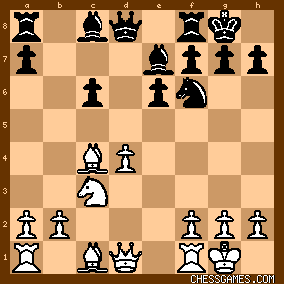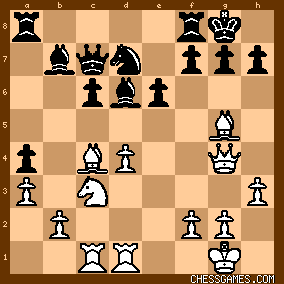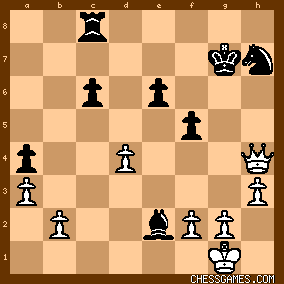| Nov-25-15 | | ICCM Bart Gibbons: Black's 8th was an error, as he was not able to get in the freeing move ...c5. 8...Ne5 was playable, but passive. 8...Bd7 was probably simplest. |
|
Aug-18-18
 | | KEG: Burn underestimated the power of Showalter's King-side build-up and got blown away by a pretty combination. 1. d4 d5
2. c4 dxc4
3. e3
Most of the opening and early middle-game play in this encounter was, to say the least, unambitious, and the game did not become particularly interesting until about move 16 or so. But neither side made any major mistakes during these stages of the game and thus my comments are somewhat in the nature of quibbles coupled with a desire to see more action. 3... e6
Sound but somewhat wimpy. 3...e5 or 3...c5 are more active. 3...Be6 is also possible, but--like the text--not not very enterprising. 4. Bxc4 Nf6
5. Nc3 c5
6. Nf3 Nc6
6...a6 leaving open the option of played the Knight to d7 looks more promising, but the text is certainly OK. 7. 0-0 Be7
7...a6 or 7...cxd4 were probably a little better. 8. Ne5
The Tournament Book awards this move a "!," but it hardly looks right. The simpler 8...dxc5 was probably best and seems to yield an advantage for White. Showalter was playing to give Burn an isolated c-pawn, but winds up getting his own isolated pawn as well. After the text, chances were about even, the Tournament Book notwithstanding. 8... cxd4
9. NxN bxN
10. exd4 0-0
The position was now:

click for larger viewBurn does have an isolated c-pawn here, but his position is otherwise solid. If Showalter had any advantage at this stage, it was tiny at best. 11. Be3
More cautious unambitious play. If Showalter wanted to try for some initiative, he could have played 11. Bf4 or 11. Na4. The text, however, is solid and careful and certainly presents no dangers for White (or for Black for that matter). 11... Bb7
11...h6 or 11...Nd5 look a little better. If Burn were seeking complications, he might have tried 11...Rb8. 12. Qe2
Still just playing it safe. 12. Rc1 or 12. Na4 would seem to be better ways to mix it up. But Showalter seemed happy for equality at this stage of the game. 12... Qa5
The first real sign of life in this game. 12...Nd5 was another possibility. 13. a3
The Tournament Book gave Showalter another "!" for this move. The move is certainly fine, but I fail to see anything especially clever let alone brilliant about the move. 13... Bd6
This effort to try to drum up pressure on h2 seems of doubtful utility. Burn had many better options, including 13...Rfd8, 13...Rad8, 13...Nd5, and 13...h6. 14. Rfd1 Qc7
15. h3
15. g3 seems a better way to protect h2.
15... a5
15...Nd5 seems better.
16. Bg5
Why not simply 16. Rac1.
The position after the foregoing often listless play was: 
click for larger viewAs I will discuss in my next post on this game, it was at this point that the game became interesting. |
|
Aug-19-18
 | | KEG: Post II
From the position with which I ended my last post, Showalter went into attack mode, and when Burn continued his uncharacteristically listless play Showalter demolished him. 16... Nd7
Hardly best, though probably playable. 16...Nd5 was clearly much stronger. 17. Rac1
When I first played over this game, I thought 17. Ne4 was much better. While that may indeed be the best move on the board, Showalter had a different plan in mind involving a King-side assault. 17... a4
Overlooking the dangers he faced on the King-side. 17...h6 should have been played here. 18. Qg4
The attack begins. Showalter may not have a won game just yet, but Burn was clearly facing trouble, as the following diagram reveals: 
click for larger view18... Kh8
19. Qh4! Rfe8
20. Ne4 f6?
A fatal weakening that costs the game. Burn had to play 20...Kg8. The position was now:

click for larger view21. NxB QxN
22. Bf4 Qe7
23. Bd2
Ready to play Bb4 now that the Black Queen is on e7. 23... Qf7
24. Bd3
24. Re1 was even better.
24... f5
Making matters even worse for himself. Burn should have girded his loins and settled down for tight defense...his only chance, with either 24...Nf8 or 24...g6. 25. Be2!
I love this move. From e2, this Bishop can strike on the King-side or return to c4 as may be needed, while keeping watch on a6 should Burn have the temerity to move his Bishop to that square. 25... Nf6
The position was now:

click for larger view26. Bf4
26. Bf3 was another good option for Showalter here. 26... Rec8
The Tournament Book assigned this move a "?", but I see nothing wrong with overprotecting the c-pawn at this stage. Burn has a tough game after this move, but he would as well in any case. 27. Be5
Although this worked out splendidly for Showalter, 27. Bf3 targeting the c6 pawn seems better. 27... Nd5?
Giving Showalter exactly what he was seeking for his e5 Bishop: a threat on g7. Burn should have taken advantage of Showalter's failure to play 27. Bf3 and tried 27...Ba6 with possible chances of holding the game. After the text, as I will attempt to show in my next post on this game, Burn was lost, the position now being: 
click for larger view |
|
Aug-19-18
 | | KEG: Post III
After Burn's poor 27th move, Showalter adopted a winning strategy that was logical, simple, and decisive. He line up his Rooks on the g-file, positioned his Bishops on e5 and g6, and then blew away Burn's defenses. As will be seen from what follows: (i) Burn had no defense against Showalter's plan; but (ii) there were faster winning procedures that Showalter could have utilized. 28. Rd3
This Rook is headed for g3 and then to g5 where it will be backed up by the other White Rook. 28. Bh5 immediately might have been faster and more brutal, but Showalter from here on stuck to his unbreakable plan. 28... Ba6?
The only possible means of offering any resistance was to try 28...Qe7 to harass the White Queen for a while, since Showalter's attack plan requires that he not trade Queens. After Burn's actual move, all was clear sailing for Showalter. 29. Bh5!
Perhaps Burn overlooked this intermediate move, which avoids the trade of Bishops. 29... Qg8
30. Rg3
All according to plan.
30... Ra7
Forced.
The position was now:

click for larger view31. Bg6!
Showalter could also won with the immediate 31. Rg5 or the more spectacular 31. Rg6! 31... Bb5
31...Rd7 or 31...Be2 were the only chances to hold out. 32. Rg5
Making room for the other Rook to join the party on the g-file. 32... Nf6
This at least temporarily blocks the pin of the g7 pawn. But the move--which was Black's best chance--nonetheless has some major problems. 33. Rc3
Relentlessly pursuing his plan of attack on the g-file. Showalter could, however, saved himself some time with the crushing 33. d5! 33... Qf8?
Burn was already lost, but this was sheer suicide. 34. Rcg3
Again relentlessly following his plan, but missing the crushing opportunities Burn's last lemon of a move provided: 34. d5! and 34. g4! The text, however, was plenty good enough.
34... Be2?
Missing his only slim chances at survival. As will be seen, leaving both the c6 pawn and the c8 Rook undefended by the Black Bishop led to disaster. In fairness, Burn was lost here whatever he did. The position now was:

click for larger viewFrom here Showalter finished nicely as I will show in my next post on this game. |
|
Aug-19-18
 | | OhioChessFan: I review a lot of your games and realize I don't comment. Thanks for your work and I assume other people are enjoying it but not commenting also. |
|
Aug-19-18
 | | Sally Simpson: Yes nice clear posts with non-computer based opinions. " I assume other people are enjoying it but not commenting." Yes. If there was something wrong or an excuse to not-pick there would be comments. |
|
Aug-19-18
 | | KEG: <OhioChessFan> <Sally Simpson> Thank you both so much for your kind remarks. I am so glad you enjoy my posts. I must confess that I do often check my calculations with Fritz and/or Stockfish. This assures me I am not doing something silly such as hanging a Rook! |
|
Aug-19-18
 | | KEG: Post IV
Showalter's winning combination following 34...Be2 began with perhaps the most obvious move on the board, but had a subtle point that Burn may have overlooked: 35. Bxh7 NxB
36. Rxg7 RxR
37. RxR QxR
38. BxQ+ KxB
This left:

click for larger viewPerhaps Burn had calculated that he would have sufficient compensation for the Queen. If so, Showalter quickly disillusioned him: 39. Qe7+ Kh8
40. Qxe6 Ba6
The position was now:

click for larger viewThis might look like it holds the game for at least a while, but Showalter's next move shatters any such belief: 41. d5! Nf8
Burn obviously could not take the d-pawn. 41...Rf8 might have allowed him to prolong the game a tad, but would hardly have changed the outcome. 42. Qxf5 Kg8
43. d6
Among his other woes, Burn must now lose a piece to stop the d-pawn from Queening. 43... Re8
44. d7 Re1+
45. Kh2 Nxd7
46. QxN Bb5
Hopeless, as was everything else, the position now being: 
click for larger viewHaving wiped out most of Burn's army, Showalter weaved a mating net: 47. h4 Re2
48. h5 Rxf2
49. h6
Burn can now only escape immediate mate at the cost of a Rook: 
click for larger view1-0
In fairness to Burn--whose weak play in this game did not display his undoubted talent--I should note that he had lost a 104-move endgame to Maroczy the round before in which he had entered the ending with a pawn plus, lost all of his advantage, and then blundered away the game on move 104. I am guessing (much as I usually detest psychological speculations about how a player I never met felt 118 years ago) that Burn must have been tired and discouraged after his exhausting and painful loss to Maroczy. |
|
Aug-20-18
 | | Sally Simpson: Hi Keg,
I was referring to this type of non-computer type comment and others like it. White has just played 25. Bd3-e2.

click for larger view"I love this move. From e2, this Bishop can strike on the King-side or return to c4 as may be needed, while keeping watch on a6 should Burn have the temerity to move his Bishop to that square." Computers do yet display a heart symbol - they may one day. |
|
Aug-20-18
 | | KEG: <Sally Simpson> Computers have not to my knowledge yet reached the point at which they can share the enthusiasm many of us have for chess. For some of us, chess is not just a game but an art. Watching combinations or strategic plans unfold can be (almost) as exhilarating as Bach, Beethoven, or Michelangelo. We feel pain when we err, and we treasure our best games even years later. I doubt computers can do this. But with the development of artificial intelligence, who knows what the future may hold! |
|
|
|
|





































